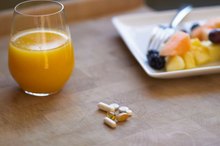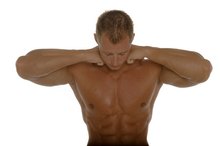Diet for Recovering Alcoholics
Excessive alcohol consumption inhibits the body’s ability to absorb nutrients, dramatically influences the diet of the heavy drinker and can result in severe malnutrition. A recovering alcoholic must not only cease using alcohol and carefully wean the body from its physical effects, but also repair the body through nutrition to reverse some of the negative affects of heavy consumption. A healthy diet, complete with supplements recommended by your doctor, can go a long way toward restoring normal body function.
If you are experiencing serious medical symptoms, seek emergency treatment immediately.
Alcoholic Diet
The consumption of alcohol tricks the body into thinking it’s been fed by providing the calories that would otherwise come from more nutrient-rich food. As drinking levels increase, alcoholics tend to satisfy more of their unmet calorie needs with fatty and sugary food, according to a study by the National Institute on Alcohol Abuse and Alcoholism, published in 2010 in the "Journal of the American Dietetic Association." Overall diet quality declines as the level of alcohol consumption increases, researchers found 1.
Nutritional Deficiencies
Vitamins & Supplements for Alcohol Recovery
Learn More
The most common dietary deficiencies in alcoholics are vitamin B6, thiamine and folic acid. These vital nutrients aid in red blood-cell production and nutrient absorption. During detoxification, or the immediate period following alcohol withdrawal, a doctor should monitor these levels and decide if supplementation is necessary to preserve healthy bodily function. He will also screen for protein, iron and electrolytes to determine what, if any, lasting damage has been done to the liver.
- The most common dietary deficiencies in alcoholics are vitamin B6, thiamine and folic acid.
- He will also screen for protein, iron and electrolytes to determine what, if any, lasting damage has been done to the liver.
Balance
There is no cure for cirrhosis of the liver or pancreatitis, two of the more common chronic conditions associated with alcoholism. There will be, however, a time when the other systemic, alcohol-related damage like inefficient nutrient absorption or low red blood-cell count will reverse itself. Diets rich in protein and low in simple sugars or saturated fats can speed this process. Build a diet plan in recovery that delivers no more than 20 to 35 percent of the daily calories from fat, with an even split between carbohydrates and protein for the rest, the U.S. Department of Agriculture’s food pyramid recommends.
- There is no cure for cirrhosis of the liver or pancreatitis, two of the more common chronic conditions associated with alcoholism.
- There will be, however, a time when the other systemic, alcohol-related damage like inefficient nutrient absorption or low red blood-cell count will reverse itself.
Supplements
Atkins Diet & Red Wine
Learn More
B-complex vitamins, particularly B12, contribute to a healthy metabolism. Your doctor may administer B12 shots or have you take B-complex supplements by mouth during your first few months of recovery. You may also need to supplement with vitamins A, C and E as well as minerals like magnesium, selenium and zinc in doses higher than the recommended daily allowance, Dr. Elson M. Haas writes for the Global Healing Center's website.
Sugar Cravings
The body converts alcohol, like other refined grains, directly to sugar, causing a spike in blood sugar levels and a commensurate insulin response to bring those levels back down. Following detox, a recovering alcoholic may find that he craves sweets and starchy foods more than he did before. This is the body’s response to its perceived insufficient blood sugar in the absence of alcohol. The acute sugar cravings should pass as other withdrawal symptoms fade, but the compulsion to eat sugary foods could remain well into an alcoholic’s recovery as a psychological replacement for alcohol 3. Sticking to your balanced diet plan and avoiding the early temptation to “medicate” against the loss of alcohol by binging on sugar should blunt the long-term effects of sugar craving as you progress through recovery.
- The body converts alcohol, like other refined grains, directly to sugar, causing a spike in blood sugar levels and a commensurate insulin response to bring those levels back down.
- The acute sugar cravings should pass as other withdrawal symptoms fade, but the compulsion to eat sugary foods could remain well into an alcoholic’s recovery as a psychological replacement for alcohol 3.
Related Articles
References
- National Institutes of Health: Diet Quality Worsens as Alcohol Intake Increases
- Global Healing Center: Nutritional Program for Alcohol Detoxification
- Sayon-Orea C, Martinez-Gonzalez MA, Bes-Rastrollo M. Alcohol consumption and body weight: a systematic review. Nutr Rev. 2011;69(8):419-431. doi:10.1111/j.1753-4887.2011.00403.x
- Wang L, Lee IM, Manson JE, Buring JE, Sesso HD. Alcohol Consumption, Weight Gain, and Risk of Becoming Overweight in Middle-Aged and Older Women. Arch Intern Med. 2010;170(5):453-461. doi:10.1001/archinternmed.2009.527
- Tremblay A, Wouters E, Wenker M, St-Pierre S, Bouchard C, Després JP. Alcohol and a high-fat diet: a combination favoring overfeeding. Am J Clin Nutr. 1995;62(3):639-644. doi:10.1093/ajcn/62.3.639
- Tremblay A, St-Pierre S. The hyperphagic effect of a high-fat diet and alcohol intake persists after control for energy density. Am J Clin Nutr. 1996;63(4):479-482. doi:10.1093/ajcn/63.4.479
- McDonald JA, Goyal A, Terry MB. Alcohol Intake and Breast Cancer Risk: Weighing the Overall Evidence. Curr Breast Cancer Rep. 2013;5(3):208-221. doi:10.1007/s12609-013-0114-z
- Shai I, Wainstein J, Harman-Boehm I, et al. Glycemic Effects of Moderate Alcohol Intake Among Patients with Type 2 Diabetes: A Multicenter, Randomized, Clinical Intervention Trial. Diabetes Care. 2007;30(12):3011-3016. doi:10.2337/dc07-1103
- Carlsson S, Hammar N, Grill V. Alcohol consumption and type 2 diabetes: Meta-analysis of epidemiological studies indicates a U-shaped relationship. Diabetologia. 2005;48(6):1051-1054. doi:10.1007/s00125-005-1768-5









